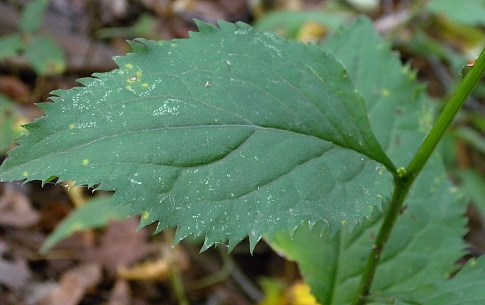Description:
This
perennial wildflower is 2-3' tall and usually unbranched. The
central stem is light green, terete or angular, and glabrous to hairy;
it has a tendency to zigzag between the alternate leaves. The leaf
blades are 2-5" long and 1-4" across, becoming shorter and more narrow
where the flowers occur; they are widely spreading. The lower
to middle leaves are ovate to broadly ovate, while the upper leaves are
more lanceolate. The leaf margins are coarsely serrated. The upper
surfaces of the leaves are medium to dark green and glabrous, while
their lowers surfaces are more pale and glabrous to slightly hairy. The
petioles are ¼–1½" long and somewhat winged near the bases of the leaf
blades. At the apex of the central stem, there is a terminal
inflorescence about 1½–5" long and about one-third as much across. This
inflorescence is either a raceme or narrow panicle of flowerheads.
There are also smaller axillary racemes about ½–1½" long that develop
from the middle to upper leaves; they are shorter than the leaves. The
branches of each inflorescence are light green and glabrous. Each
flowerhead is about ¼" across or a little less, consisting of 3-4
yellow ray florets, 4-8 yellow disk florets, and several series of
floral bracts at its base. The floral bracts are light green and
appressed. The blooming period occurs from late summer to early fall
and lasts about 1 month. Both ray and disk florets are fertile. During
the fall, the florets are replaced by achenes with small tufts of hair;
they are distributed by the wind. The small achenes are bullet-shaped
and pubescent. The root system is fibrous and rhizomatous. Vegetative
colonies of plants are sometimes formed from the spreading rhizomes.
widely spreading. The lower
to middle leaves are ovate to broadly ovate, while the upper leaves are
more lanceolate. The leaf margins are coarsely serrated. The upper
surfaces of the leaves are medium to dark green and glabrous, while
their lowers surfaces are more pale and glabrous to slightly hairy. The
petioles are ¼–1½" long and somewhat winged near the bases of the leaf
blades. At the apex of the central stem, there is a terminal
inflorescence about 1½–5" long and about one-third as much across. This
inflorescence is either a raceme or narrow panicle of flowerheads.
There are also smaller axillary racemes about ½–1½" long that develop
from the middle to upper leaves; they are shorter than the leaves. The
branches of each inflorescence are light green and glabrous. Each
flowerhead is about ¼" across or a little less, consisting of 3-4
yellow ray florets, 4-8 yellow disk florets, and several series of
floral bracts at its base. The floral bracts are light green and
appressed. The blooming period occurs from late summer to early fall
and lasts about 1 month. Both ray and disk florets are fertile. During
the fall, the florets are replaced by achenes with small tufts of hair;
they are distributed by the wind. The small achenes are bullet-shaped
and pubescent. The root system is fibrous and rhizomatous. Vegetative
colonies of plants are sometimes formed from the spreading rhizomes.
Cultivation:
The preference is light to medium shade, moist to dry-mesic conditions
in sheltered situations, and fertile loamy soil with decaying organic
matter. This is one of the most shade-tolerant goldenrods.
Range & Habitat:
The native Zigzag Goldenrod is occasional in central and northern
Illinois,
becoming uncommon or absent in the southern section of the state (see Distribution
Map). Habitats include rich deciduous woodlands, protected
wooded slopes facing north or east, calcareous seeps in wooded areas,
low areas along woodland streams, shaded limestone cliffs, and edges of
limestone glades. This wildflower is usually found in higher quality
natural areas.
Faunal Associations:
The flowerheads are pollinated by many kinds of insects, including
long-tongued bees, small-tongued bees, wasps, flies, and butterflies.
Several bees are oligoleges of Solidago spp.
(Goldenrods). These species include: Andrena hirticincta,
Andrena nubecula, Andrena placata,
Andrena simplex, Andrena solidaginis,
and Colletes simulans armata. Many insects feed on
the leaves, flowers, seeds, and roots of goldenrods. These insect
feeders include plant bugs, stink bugs, aphids, leaf beetles, and the
caterpillars of many moths (see the Moth Table and the Insect
Table for a listing of these species). These insects are a
source of food to many woodland songbirds and some upland gamebirds.
White-tailed Deer readily browse on the foliage of Zigzag Goldenrod.

Photographic
Location:
A wooded slope at Turkey Run State Park in west-central Indiana.
Comments:
Zigzag Goldenrod is a member of a small group of woodland goldenrods
(Solidago spp.); other species in this group include Solidago
caesia (Bluestem Goldenrod) and Solidago ulmifolia
(Elm-Leaved Goldenrod). Zigzag Goldenrod often occurs more moist
habitats than the latter two goldenrods, but it also occurs in drier
areas of woodlands that are sheltered from the prevailing winds and
afternoon sunlight. Because of its broad coarsely toothed leaves and
axillary racemes of flowerheads, it is one of the easiest goldenrods to
identify. Another common name of this species is Broad-Leaved Goldenrod.